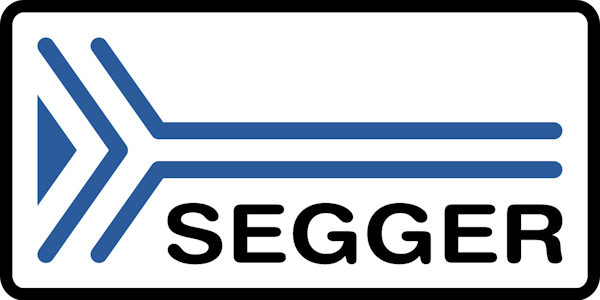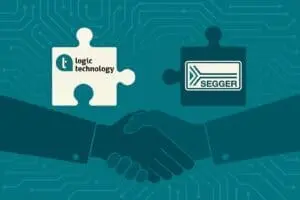
Software debugging and tracing of executed code in order to find coding flaws and errors requires tools that are powerful, flexible and highly configurable for the task at hand. Especially when debugging an application running on a Real Time Operating System (RTOS). On top of that, CI/CD forces these tools out of their stand-alone legacy environment and into a range of software ecosystems. New perspectives about debugging software have created a new breed of tools combining all these aspects in powerful visually enhanced software aids.
Our brands


Our brands


Related articles

PRESS RELEASE – Logic Technology Becomes Official SEGGER Distributor in the Benelux
Logic Technology proudly announces it is the new official SEGGER Benelux distributor. This strategic alignment ensures embedded systems developers across the region benefit from local expertise and full support for...
Read more
LDRA Joins Renesas Ready Partner Network and R-Car Consortium to Accelerate Safety-Critical Software Development, Verification and Certification
Read more
5 Reasons Why Zephyr RTOS Will Rule the Embedded World
Read more
To Observe > To Debug
Read more
Whitepaper – Effective power interruption testing – how best to fail
Read more
On this page you will find our Logic Solutions for JTAG-type debugging as well as software based tools for RTOS debugging. Not sure what the best solution is for your use case? Contact us!

RTOS tracing tools are essential for developers working with real-time operating systems (RTOS) due to the complexities inherent in multi-threaded and event-driven systems. Here's a breakdown of why they're needed, the benefits they offer, and the risks of not using them.
Why RTOS Tracing Tools Are Necessary
- Complexity of RTOS: RTOS environments involve multiple tasks running concurrently, sharing resources, and communicating with each other. This intricate interplay makes it difficult to understand the system's behavior using traditional debugging methods.
- Time-Critical Behavior: RTOS applications often have strict timing requirements. Understanding task execution order, context switching, and interrupt handling is crucial for ensuring real-time performance.
- Intermittent and Hard-to-Reproduce Bugs: Issues like race conditions, deadlocks, and priority inversions can be difficult to reproduce and diagnose without detailed insight into the system's runtime behavior.
Benefits of Using RTOS Tracing Tools
- Improved Understanding of System Behavior: Tracing tools provide a detailed timeline of events, showing task scheduling, interrupts, resource access, and inter-task communication. This allows developers to visualize the system's dynamics and identify performance bottlenecks or unexpected behavior.
- Faster Debugging: By providing a clear view of what's happening within the RTOS, tracing tools significantly reduce the time spent on debugging complex issues. Developers can quickly pinpoint the root cause of problems instead of relying on guesswork or time-consuming manual analysis.
- Performance Optimization: Tracing tools can help identify performance bottlenecks, such as excessive context switching, long interrupt handlers, or inefficient resource usage. This information enables developers to optimize their code for better real-time performance.
- System Verification and Validation: Tracing tools can be used to verify that the system behaves as expected under various conditions. This is particularly important in safety-critical applications where correctness and reliability are paramount.
Risks of Not Using an RTOS Tracer
- Increased Development Time: Without tracing tools, debugging RTOS applications can be extremely time-consuming and frustrating. Developers may spend countless hours trying to reproduce and diagnose issues, leading to project delays.
- Difficulty in Finding Root Causes: Intermittent and complex bugs can be very difficult to track down without detailed tracing information. This can lead to patches that mask symptoms rather than addressing the underlying problem.
- Reduced System Reliability: Undetected or unresolved issues can lead to unpredictable system behavior, crashes, or even safety hazards in critical applications.
- Challenges in Performance Tuning: Optimizing RTOS performance without tracing tools is like navigating in the dark. Developers may make changes that have unintended consequences or fail to identify the most effective optimizations.
In Summary
RTOS tracing tools are essential for developers working with real-time operating systems. They provide valuable insights into system behavior, accelerate debugging, aid in performance optimization, and improve overall system reliability. The risks of not using these tools include increased development time, difficulty in finding root causes of bugs, reduced system reliability, and challenges in performance tuning.
Segger
SEGGER offers a wide range of J-Link debug probes to cater to different user needs, from hobbyists and students to large-scale professional development teams. The primary difference between models lies in their speed, connectivity, and bundled software features.
All software is included free of charge. It comes with licenses for all J-Link related SEGGER software products, such as J-Link Unlimited Flash Breakpoints, Ozone, RDI/RDDI, J-Flash, J-Link GDB Server, providing the optimum debugging solution for professional developers. Software is available on Windows , Linux & macOS.
J-Link Models and Use Cases
- J-Link BASE: This is the entry-level professional model. It offers solid performance for most standard development tasks and supports a wide range of microcontrollers.
- Use Case: Suitable for small teams or individual developers who need a reliable debugger for day-to-day work without the need for the highest speeds or advanced features like unlimited flash breakpoints.
- J-Link PLUS: This is a step up from the BASE model, including built-in licenses for key software features like Unlimited Flash Breakpoints and the J-Flash programming application. It offers a more complete debugging and programming experience out of the box.
- Use Case: A great all-around tool for professional developers who want full access to the J-Link software ecosystem, including efficient flash programming and the ability to set numerous breakpoints for complex code.
- J-Link ULTRA+: This model provides a significant boost in performance, offering much higher download speeds and target interface speeds. It's designed for developers who need to minimize the time spent on flashing firmware.
- Use Case: Best for large, complex projects with very big firmware images, where every second saved on a download is a valuable gain. It's often used in high-performance computing and industrial applications.
- J-Link PRO: The flagship J-Link model combines the fastest possible speeds with robust connectivity options, including both USB and Ethernet. The Ethernet port allows for remote debugging and integration into test farms or automated setups.
- Use Case: The premier choice for enterprise-level development, test automation, and environments where multiple engineers might need to access a target board remotely.
| Feature | J-Link BASE | J-Link PLUS | J-Link ULTRA+ | J-Link PRO |
|---|---|---|---|---|
| Target Audience | Professional Developers | Professional Developers | High-Performance Dev. | Enterprise & Test Farm |
| Max. Target Speed | 15 MHz | 15 MHz | 50 MHz | 50 MHz |
| PC Interface | USB | USB | USB | USB & Ethernet |
| Flash Download Speed | Up to 1 MB/s | Up to 1 MB/s | Up to 4 MB/s | Up to 4 MB/s |
| Key Licenses | None (Basic Software) | All included | All included | All included |
| Unlimited Flash Breakpoints | No | Yes | Yes | Yes |
| VCOM Support | Yes | Yes | Yes | Yes |
| Target Power Supply | Limited | Yes | Yes | Yes |
| Notable Feature | Entry-level professional | Bundled licenses | Maximum USB speed | Ethernet for remote acces |
| Use Case | Standard development | General professional use | High-performance, big firmware | Test automation, large teams |
SystemView
SEGGER's SystemView is a powerful trace-analysis tool for verifying and validating embedded systems. Designed for embedded software testing, it records, analyzes, and visualizes captured data in real time; documents tasks, interrupts, and user events; and much more.
J-Trace PRO
J-Trace PRO is SEGGER's "all-in-one" streaming trace probe for any popular CPU core and architecture. It combines all the debug capabilities of the market-leading J-Link with the analyzing, verifying and code-profiling features of the J-Trace for Arm- and RISC-V-based architectures.
J-Trace PRO for Cortex-M
J-Trace PRO for Cortex-A/R/M-based microcontrollers supports tracing on a wide range of Arm Cortex cores.
J-Link WiFi
J-Link WiFi is a JTAG/SWD debug probe with WLAN/WiFi interface. It can communicate at high speed (up to 15MHz) with the supported target CPUs. If a wireless debug interface is required, J-Link WiFi is the perfect solution.
J-Link ULTRA plus
J-Link ULTRA+ is an ultra-fast debug probe for JTAG/SWD. It is 100% compatible with J-Link PLUS, just faster.
J-Link PRO
J-Link Pro is SEGGER's versatile JTAG/SWD programming and debug probe with USB and Ethernet interfaces.
J-Link PLUS
J-Link PLUS is a USB-powered JTAG debug probe supporting a large number of CPU cores. Based on a 32-bit RISC CPU, it can communicate at high speed with the supported target CPUs. J-Link is used around the world in tens of thousands of places for development and production (flash programming) purposes.
Percepio Tracealyzer
Percepio Tracealyzer, is a visual trace observability tool that helps developers to speed up debugging, make faster progress, and deliver great products with confidence.
Percepio DevAlert
Percepio DevAlert is a cloud-based service that provides continuous observability for embedded software. DevAlert helps developers proactively identify and address issues in their firmware remotely.
Percepio Detect
Percepio Detect is designed to enhance observability during the testing and QA phases of embedded software development.
J-Trace PRO RISC-V
J-Trace PRO for RISC-V-based microcontrollers supports tracing on a wide range of RISC-V cores.
J-Link Pro PoE
J-Link Pro PoE is SEGGER's specialized programming and debug probe for creating test farms. It can draw power via Ethernet and supplies power to the target either via debug interface or a USB A connector.

André De Ceuninck
Software Quality | Testing | Certification
Develop and Deploy with Continuous Observability
Upscaling software issue detecting over a multitude of remote devices is possible today. Give me 30 minutes of your time and gain weeks of development time.